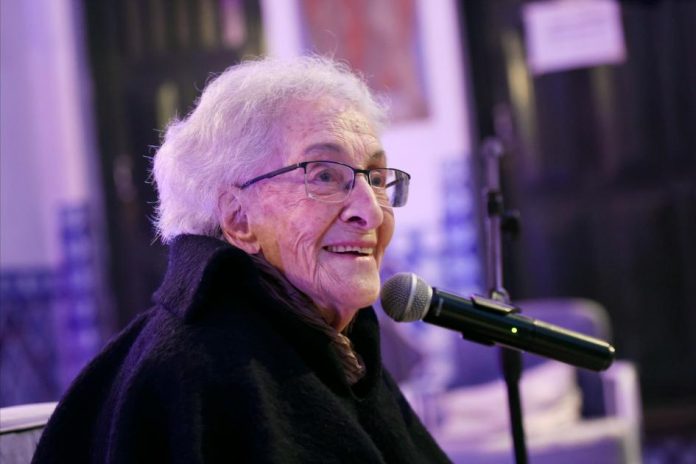Gran Premio Nacional a la Labor Intelectual
La escritora, poeta, traductora y ensayista Ida Vitale, es la ganadora del Gran Premio Nacional a la Labor Intelectual según anunció el ministro de Educación y Cultura, Pablo da Silveira, en conferencia de prensa.
Da Silveira manifestó su honor al poder entregarle este premio “a una figura absolutamente descollante de las letras uruguayas”. Destacó en Vitale su enorme y prolongada presencia en las letras uruguayas con una larga trayectoria como docente y traductora.
A nivel internacional recibió los Premios Cervantes, Max Jacob y Reina Sofía, entre otros.
Según establece la Ley N° 19.252, este galardón se otorga cada tres años a personalidades destacadas en actividades culturales con el fin de reconocer la excelencia, creatividad y contribución a la cultura nacional.
Un tribunal integrado por 16 miembros de destacada trayectoria en el ámbito cultural, académico y artístico, presidido por Pablo Atchugarry, estuvo a cargo de la elección.
La ceremonia de entrega se realizará el viernes 3 de diciembre a la hora 12:30 en el Museo de Artes Decorativas – Palacio Taranco – 25 de mayo 376 -.



excelente señora.-
Thai farmer forced to kill more than 100 endangered crocodiles after a typhoon damaged their enclosure
[url=https://krmp10.cc]kraken зеркало[/url]
A Thai crocodile farmer who goes by the nickname “Crocodile X” said he killed more than 100 critically endangered reptiles to prevent them from escaping after a typhoon damaged their enclosure.
Natthapak Khumkad, 37, who runs a crocodile farm in Lamphun, northern Thailand, said he scrambled to find his Siamese crocodiles a new home when he noticed a wall securing their enclosure was at risk of collapsing. But nowhere was large or secure enough to hold the crocodiles, some of which were up to 4 meters (13 feet) long.
To stop the crocodiles from getting loose into the local community, Natthapak said, he put 125 of them down on September 22.
“I had to make the most difficult decision of my life to kill them all,” he told CNN. “My family and I discussed if the wall collapsed the damage to people’s lives would be far bigger than we can control. It would involve people’s lives and public safety.”
Typhoon Yagi, Asia’s most powerful storm this year, swept across southern China and Southeast Asia this month, leaving a trail of destruction with its intense rainfall and powerful winds. Downpours inundated Thailand’s north, submerging homes and riverside villages, killing at least nine people.
Storms like Yagi are “getting stronger due to climate change, primarily because warmer ocean waters provide more energy to fuel the storms, leading to increased wind speeds and heavier rainfall,” said Benjamin Horton, director of the Earth Observatory of Singapore.
Natural disasters, including typhoons, pose a range of threats to wildlife, according to the International Fund for Animal Welfare. Flooding can leave animals stranded, in danger of drowning, or separated from their owners or families.
Rain and strong winds can also severely damage habitats and animal shelters. In 2022, Hurricane Ian hit Florida and destroyed the Little Bear Sanctuary in Punta Gorda, leaving 200 animals, including cows, horses, donkeys, pigs and birds without shelter.
The risk of natural disasters to animals is only increasing as human-caused climate change makes extreme weather events more frequent and volatile.
Plan1&1
http://gogotire.co.kr/bbs/board.php?bo_table=free&wr_id=1355224
Thai farmer forced to kill more than 100 endangered crocodiles after a typhoon damaged their enclosure
[url=https://krmp10.cc]кракен вход[/url]
A Thai crocodile farmer who goes by the nickname “Crocodile X” said he killed more than 100 critically endangered reptiles to prevent them from escaping after a typhoon damaged their enclosure.
Natthapak Khumkad, 37, who runs a crocodile farm in Lamphun, northern Thailand, said he scrambled to find his Siamese crocodiles a new home when he noticed a wall securing their enclosure was at risk of collapsing. But nowhere was large or secure enough to hold the crocodiles, some of which were up to 4 meters (13 feet) long.
To stop the crocodiles from getting loose into the local community, Natthapak said, he put 125 of them down on September 22.
“I had to make the most difficult decision of my life to kill them all,” he told CNN. “My family and I discussed if the wall collapsed the damage to people’s lives would be far bigger than we can control. It would involve people’s lives and public safety.”
Typhoon Yagi, Asia’s most powerful storm this year, swept across southern China and Southeast Asia this month, leaving a trail of destruction with its intense rainfall and powerful winds. Downpours inundated Thailand’s north, submerging homes and riverside villages, killing at least nine people.
Storms like Yagi are “getting stronger due to climate change, primarily because warmer ocean waters provide more energy to fuel the storms, leading to increased wind speeds and heavier rainfall,” said Benjamin Horton, director of the Earth Observatory of Singapore.
Natural disasters, including typhoons, pose a range of threats to wildlife, according to the International Fund for Animal Welfare. Flooding can leave animals stranded, in danger of drowning, or separated from their owners or families.
Rain and strong winds can also severely damage habitats and animal shelters. In 2022, Hurricane Ian hit Florida and destroyed the Little Bear Sanctuary in Punta Gorda, leaving 200 animals, including cows, horses, donkeys, pigs and birds without shelter.
The risk of natural disasters to animals is only increasing as human-caused climate change makes extreme weather events more frequent and volatile.
Thai farmer forced to kill more than 100 endangered crocodiles after a typhoon damaged their enclosure
[url=https://krmp10.cc]kraken магазин[/url]
A Thai crocodile farmer who goes by the nickname “Crocodile X” said he killed more than 100 critically endangered reptiles to prevent them from escaping after a typhoon damaged their enclosure.
Natthapak Khumkad, 37, who runs a crocodile farm in Lamphun, northern Thailand, said he scrambled to find his Siamese crocodiles a new home when he noticed a wall securing their enclosure was at risk of collapsing. But nowhere was large or secure enough to hold the crocodiles, some of which were up to 4 meters (13 feet) long.
To stop the crocodiles from getting loose into the local community, Natthapak said, he put 125 of them down on September 22.
“I had to make the most difficult decision of my life to kill them all,” he told CNN. “My family and I discussed if the wall collapsed the damage to people’s lives would be far bigger than we can control. It would involve people’s lives and public safety.”
Typhoon Yagi, Asia’s most powerful storm this year, swept across southern China and Southeast Asia this month, leaving a trail of destruction with its intense rainfall and powerful winds. Downpours inundated Thailand’s north, submerging homes and riverside villages, killing at least nine people.
Storms like Yagi are “getting stronger due to climate change, primarily because warmer ocean waters provide more energy to fuel the storms, leading to increased wind speeds and heavier rainfall,” said Benjamin Horton, director of the Earth Observatory of Singapore.
Natural disasters, including typhoons, pose a range of threats to wildlife, according to the International Fund for Animal Welfare. Flooding can leave animals stranded, in danger of drowning, or separated from their owners or families.
Rain and strong winds can also severely damage habitats and animal shelters. In 2022, Hurricane Ian hit Florida and destroyed the Little Bear Sanctuary in Punta Gorda, leaving 200 animals, including cows, horses, donkeys, pigs and birds without shelter.
The risk of natural disasters to animals is only increasing as human-caused climate change makes extreme weather events more frequent and volatile.
Can these ultra-exclusive luxury destinations help extend your life? They’d certainly like to try
[url=https://pinup-india.in/]promo code for pin up casino[/url]
When the Six Senses Residences Dubai Marina is completed in 2028, the gleaming 122-story building will be the tallest residential structure in the world, complete with luxury fitness and wellness amenities to match. Residents will be able to lift weights, take an outdoor yoga class or swim laps in a pool more than 100 stories high in the clouds.
But what if, by living there, people were also extending their lives? That’s the mission of the “longevity floor,” another amenity available to future residents of the Six Senses’ 251 apartments and “sky mansions.” This unique floor will include even more specialized offerings such as crystal sound healing, believed by its practitioners to reduce stress and improve sleep. Or residents can indulge in hyperbaric treatments, breathing in 100% oxygen in a pressurized chamber which has shown promising anti-aging results.
“The idea around it is that you’re not just purchasing a residence, you’re purchasing a lifestyle,” said Kevin Cavaco, director of marketing for Select Group, the building’s developer.
“You’re purchasing an opportunity to work on your true wealth — which is your longevity. You’re prolonging your time.”
Life extension may be a lofty — and dubious — pitch, but it’s a common theme among luxury fitness clubs, opulent new high rises and exclusive retreats. The trend coincides with new scientific studies and a parallel fixation in the tech world, but the provable science behind these promises is often murky.
Celebrity personal trainer and gym designer Harley Pasternak is used to designing programs for high-profile celebrities including Kim Kardashian, Lady Gaga and Halle Berry. But he’s noticed a shift in the past few years, he told CNN over email, as he’s gained an “influx” of tech founder clients.
“All of them are definitely more interested in aging, in a way that I’ve never seen prior to five years ago,” he said. “All kinds of biohacking tricks like heat exposure, cold, exposure, certain supplements, training, foraging, and even certain medications.”
The magical white stone wonderland with effervescent bathing pools
[url=https://1x-bet-casino.in/always-available/]1xbet casino bonus[/url]
From a distance, Pamukkale looks every bit like a ski resort, with a cascade of brilliant white slopes and a scattering of tourists at the top, seemingly preparing to slalom down into the valley below.
So why isn’t it melting away as midsummer temperatures nudge toward 100 Fahrenheit, or 37 Celsius, and the heat hangs in the shimmering air?
Because this unusual and beautiful wonder, located deep in the sunkissed hills of southwestern Turkey, isn’t snow at all. In fact the water it’s formed from sometimes spurts out of the ground at boiling point.
And those visitors milling around its upper reaches aren’t going anywhere fast. Most are here to take in the extraordinary spectacle – and either paddle or soak in some of the planet’s most photogenic pools.
Today, Pamukkale’s travertine limestone slopes and pools, filled with milky blue mineral water, are perfect for Instagram moments, especially as the magic hour evening sun casts their rippled surfaces in hues of pink.
Gateway to Hell
But this place was a tourist sensation thousands of years before social media, as first Greeks, then Romans flocked here for the thermal waters and to pay tribute at what was revered as a gateway to Hell.
Today, Pamukkale and the ancient city of Hierapolis, which sprawls across the plateau above the white terraces, are part of a UNESCO World Heritage site that pulls in coachloads of visitors. Typically, many visit for a couple of hours, but it’s worth spending at least a day in this geological and historical playground.